EU and US FDA-approved Cerebrotech Visor device could be a defibrillator for stroke
Source: Cerebrotech Medical System Nov 01, 2018 7 years, 2 months, 2 weeks, 4 days, 12 hours, 11 minutes ago
A portable, visor-like device has shown potential for detecting emergent large-vessel occlusion with 92% accuracy in patients who may have had a stroke. The researchers suggest that the diagnostic device could be readily accessible to emergency personnel and in public spaces in the same way a defibrillator is available for treating heart attacks.
Researchers and clinical investigators Medical University of South Carolina (MUSC), Mount Sinai and the University of Tennessee Health Sciences Center reported that patients who had a large-vessel occlusion and used the device could be sent to a comprehensive stroke center that had the capabilities to treat stroke. The device has better potential of identifying occlusion when compared to standard physical examination that has only shown 40% to 89% accuracy in identifying large-vessel occlusion.
The device, known as the Cerebrotech Visor, was created by Cerebrotech Medical System and is a volumetric impedance phase shift spectroscopy (VIPS) device. It sends low-energy radio waves through the brain that are able to change frequency if passing through fluids. The waves can then be reflected back through the brain and get detected by the VIPS device. If a patient is experiencing a severe stroke, the fluid in the brain changes and creates asymmetric radio waves that the Cerebrotech Visor can detect. The more asymmetric the waves are, the more severe of a stroke the patient is experiencing.
A stroke occurs when blood flow to an area of the brain is cut off, resulting in a deprivation of oxygen to brain cells, which then start to die. When brain cells die during a stroke, the abilities of that area of the brain are lost. Nearly 800,000 people a year experience a new or recurrent stroke in the U.S., according to the National Stroke Association.
Currently, patients who have an emergent large-vessel occlusion go through endovascular therapy within 24 hours. However, chances of a good outcome are decreased by about 20% after each hour that passes without treatment.
The researchers on the study suggest that the device could provide better outcomes following a stroke if emergency
medical personnel in the field could use it. The Cerebrotech Visor’s accuracy helps emergency personnel make a decision on where a patient should be taken since it is not necessarily the law to take them directly to a comprehensive stroke center.
“Transfer between hospitals takes a lot of time,” Raymond Turner, professor of neurosurgery and one of the researchers on the study said.
’If we can give the information to emergency personnel out in the field that this is a large-vessel occlusion, that should change their thought process in triage as to which
hospital they go to.”
During this study, Cerebrotech Visors were sent with emergency medical personnel in regions that have five comprehensive stroke centers that have endovascular capabilities to treat large-vessel occlusions that could cause a severe stroke. The study was designed to accurately identify severe stroke and compare those results with traditional physical examinations that emergency personnel currently practice.
The study evaluated healthy patients and patients with suspected stroke using the VIPS device. Each patient received three r
eadings that took about 30 seconds each and were later evaluated by a neurologist who used neuroimaging to give a definite diagnosis.
Cerebrotech Visor had 92% accuracy when compared to the neurologist’s diagnoses. It was able to detect the difference between patients who had a severe stroke, mild stroke or no brain pathology at all. The device was not tested in patients who have cranial implants as the metal can interfere with the device’s radio frequencies.
Cerebrotech Medical Systems paid consultants to analyze neuroimaging data to teach the VIPS device which radio waves were likely stroke. Consultants did not have access to VIPS radio wave data while reviewing images.
The researchers hope to expand the VIPS device so it can use complex machine learning algorithms to teach the difference between minor and severe stroke without the need for neurologists. They also hope that the device could be used in public spaces like a defibrillator.
“This could potentially be something like a defibrillator,” Turner said. “You can find out if a patient is having a stroke, just like you can put a defibrillator on a patient to see if they’re having a heart attack.”
The research was published in the Journal of Neurointerventional Surgery and was funded by Cerebrotech Medical Systems.
